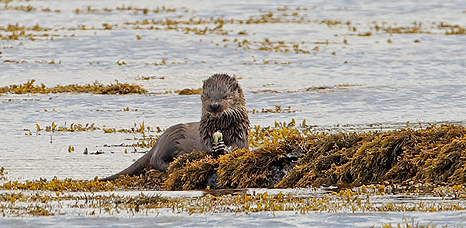Alison Uren travelled on our 'Scotland's Mammals & Highlights of the Highlands' tour and submitted this entry to our writing competition.
European Otter by Alain Verstraete
Scotland's Mammals & highlights of the Highlands
Ardnamurchan. In Scottish Gaelic, it means ‘Headland of the Great Seas, and it lives up to its romantic name. It is remote and quiet, with very few roads, rolling hills covered in heather, and marshes resplendent with Purple Loosestrife. The coastline is indented with small secret bays, where gulls and oystercatchers cry, and herons stand sentinel. You are always aware of the sky, the light, and the ever-changing colours. Warm sunshine can give way in a moment to glowering clouds; Loch Sunart can be a blinding blue, a glassy mirror, and a threatening mass of grey waves all in the same hour.
Marcus John, our tour leader, describes Ardnamurchan as his spiritual home. He loves it with a passion, and by the end of the week we loved it too. On the first day we drove to Ardnamurchan Point, the most westerly tip of the British mainland, scanning every bay for Otters, which were undoubtedly our main target species. We were rewarded with herons, Greenshank, swallows, a Hen Harrier, and a row of Twite sitting chattering on a telephone wire. A few porpoises appeared, swimming past the headland in leisurely fashion. The night drive revealed masses of Red Deer and our first very brief glimpse of a Pine Marten. But no Otters.
The second day was another drive, this time to Sanna on the north side of the peninsula. We looked for Otters everywhere, and also scanned the skies for eagles – none appeared. We put food out in the evening at the Glenborrodale Centre where we were staying for the Pine Marten, which never came. Marcus said: be patient, wildlife can be elusive.
The next day our luck began to change. The boat trip to Coll was fantastic; the sun shone and the sea was calm, and as we passed Mull a White-tailed Eagle suddenly appeared over the trees, circling over our boat for 15 minutes, remarkably close. Manx Shearwaters skimmed the water near the boat, Guillemots bobbed on the surface, and two of us saw a Basking Shark do a spectacular leap out of the water – the others were all looking in the wrong direction! In the evening the Pine Marten at last appeared; he was much admired and photographed while he enjoyed his peanut butter sandwiches. At 5am he was there again, happily munching nuts in the early morning light.
By the fourth day we were all wondering if we were ever going to see an Otter. We took a boat around Carna, where there are supposed to be several; no luck at all. It rained all morning, and we were downhearted. The Red-throated Divers were some compensation and the Arctic Terns were noisy and spectacular. When the clouds rolled away there was a crystal sharp rainbow over the lake, as if to say, this is a beautiful place, and there is always the promise of more to come.
On the fifth day, Marcus said, we are going to find those Otters. We scoured the bays all morning. We imagined rocks were Otters and we trained the telescope on otter-shaped lumps of seaweed. At midday, Marcus spotted one a long way off. We were so excited we almost fought over the telescope. It vanished around a headland; was that all we were going to see? Marcus stuffed us all in the minibus and drove us round to a vantage point in the next bay – he was sure the Otter would appear there in a few minutes. Sure enough, it did, and now there were clearly two Otters! They were jumping in and out of the water, feeding and playing, and we all excitedly took very bad pictures of rocks where the Otters had been and had just vanished. They came closer and closer, until they were in the seaweed at the edge of the bay near where we were standing. We had a grandstand view for 45 minutes! Marcus said in 20 years of otter-watching he had never had such a prolonged and close-up view of Otters as that. What a privilege, and what a spectacle. Eventually both Otters caught large fish and disappeared up the bank into the bushes.
Our final day was wet, and the highlight was the cream tea at Acharacle. Who cares - we had seen what we had come for. Wildlife is unpredictable and that is part of its attraction. Even with the best guide in the perfect place, it may not appear. When it does, it is the thrill of a lifetime.
Read more about our 'Scotland's Mammals & Highlights of the Highlands' holiday.

 Loading search...
Loading search...
